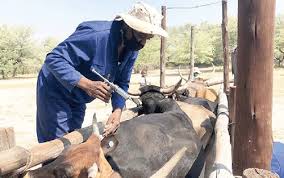Disease can be defined as any abnormal structural or functional change in the tissues of animals. The direct or indirect causes of disease are numerous, and in cattle, these can be grouped into trauma, chemical causes, faulty nutrition, poisons, internal and external parasites, bacteria, viruses, and congenital conditions.
A parasite is a plant or animal that lives on or within another living organism, obtaining an advantage at the host’s expense.
Mechanical Causes of Disease
Mechanical causes are involved not only in external injuries but also in conditions such as stomatitis caused by awns (a long, sharp part of a seed), mechanical pneumonia, traumatic gastritis (inflammation of the stomach), and injuries due to interference during birth (parturition) by untrained individuals.
Read Also: Introduction to Fishing Gear Technology
Chemical Causes of Disease
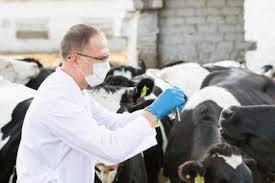
Chemical causes may produce injury through caustic action, but the main abnormal conditions arise from the absorption of chemical poisons following accidental exposure, or from toxic drugs due to improper administration.
Examples include poisoning by sodium nitrate, arsenic, and various other chemicals. Plant poisoning is another example of chemical-related disease.
Faulty Nutrition and Disease
Faulty nutrition plays a role in the development of many animal diseases. It is important for cattle farmers to have up-to-date knowledge of nutrition and nutritional deficiencies to prevent these issues.
Infectious Agents: Bacteria, Viruses, and Protozoans
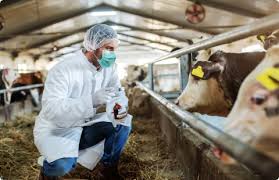
Infectious agents such as bacteria, viruses, and protozoans invade the body through various means, including the digestive, respiratory, and genito-urinary tracts, as well as the skin.
The ability of these agents to cause disease depends on their virulence, the level of exposure (number of organisms), and the resistance of the host. Infectious agents are transmitted between animals by biting insects, direct contact with infected or carrier animals, or indirectly through contaminated environments.
1. Bacterial Diseases in Cattle
Diseases caused by bacteria include anthrax, which is transmitted through water and food contaminated with blood or excretions, or by wound infections. Anthrax has an incubation period of a few hours to 1–2 weeks and can cause sudden death in cattle.
Prevention is possible through vaccination. Another example is contagious bovine pleuropneumonia (CBPP), transmitted by close contact with infected animals or inhalation of disease organisms.
The incubation period is 14 days to several months, with symptoms including frequent painful coughing, gasping, and thick mucus discharge from the mouth and nose. The animal usually dies within 1–3 days. Prevention involves vaccination and culling of acutely infected animals.
2. Viral Diseases in Cattle
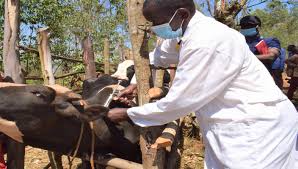
Viral diseases of cattle include foot-and-mouth disease (FMD), which is transmitted through direct contact or contact with materials contaminated by lesions or wind-borne particles. Symptoms include excessive salivation, blisters on the tongue and feet, high fever, and lameness.
Prevention is achieved through segregation, isolation of infected premises, strict sanitation, and vaccination of valuable livestock. Another viral disease is rinderpest (cattle plague), transmitted through direct contact or contaminated materials.
Symptoms include high fever, blood-stained diarrhea, severe mouth lesions, and outbreaks affecting many animals. Prevention involves vaccinating calves and a booster 12 months later.
3. Protozoan Diseases in Cattle
Protozoan diseases include trypanosomiasis (Magana), transmitted by tsetse flies. This disease causes intermittent fever, restlessness, progressive emaciation, reduced productivity, and death. Prevention involves fly eradication, the use of trypanosomiasis-tolerant cattle breeds, or chemoprophylaxis.
Another example is piroplasmosis (babesiosis or redwater), transmitted by infective ticks, which causes fever, reddish urine, and progressive weakness. Prevention focuses on tick control and immunization.
Read Also: Fish Biology: Anatomy, Physiology, Embryology and Endocrinology
Internal and External Parasites of Cattle
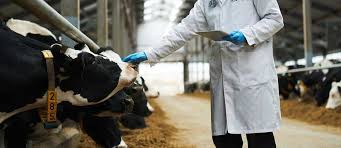
Internal parasites in cattle include protozoa and helminths (worms), causing various diseases like anaplasmosis and coccidiosis. External parasites such as ticks and biting flies cause diseases known as rickettsial diseases, such as heartwater, which presents with high fever, neurological symptoms, and sudden death.
Another parasitic disease is anaplasmosis, caused by infective ticks, biting flies, or contaminated instruments. Signs include high fever, jaundice, labored breathing, and unsteady gait, varying from acute to mild and chronic. Prevention includes chemotherapy in early stages and vaccination.
In conclusion disease can be defined as any abnormal structural or functional change in the tissues of the body. The direct or indirect causes of disease are numerous, and in cattle, these include trauma, chemical causes, faulty nutrition, poisons, internal and external parasites, bacteria, viruses, protozoans, and congenital conditions.
This article aims to provide an understanding of common diseases and parasites in cattle, their effects on cattle production, and methods of prevention.
Do you have any questions, suggestions, or contributions? If so, please feel free to use the comment box below to share your thoughts. We also encourage you to kindly share this information with others who might benefit from it. Since we can’t reach everyone at once, we truly appreciate your help in spreading the word. Thank you so much for your support and for sharing!
Read Also: Impact of Agricultural Wastes on Human and Environment
Frequently Asked Questions
We will update this section soon.

